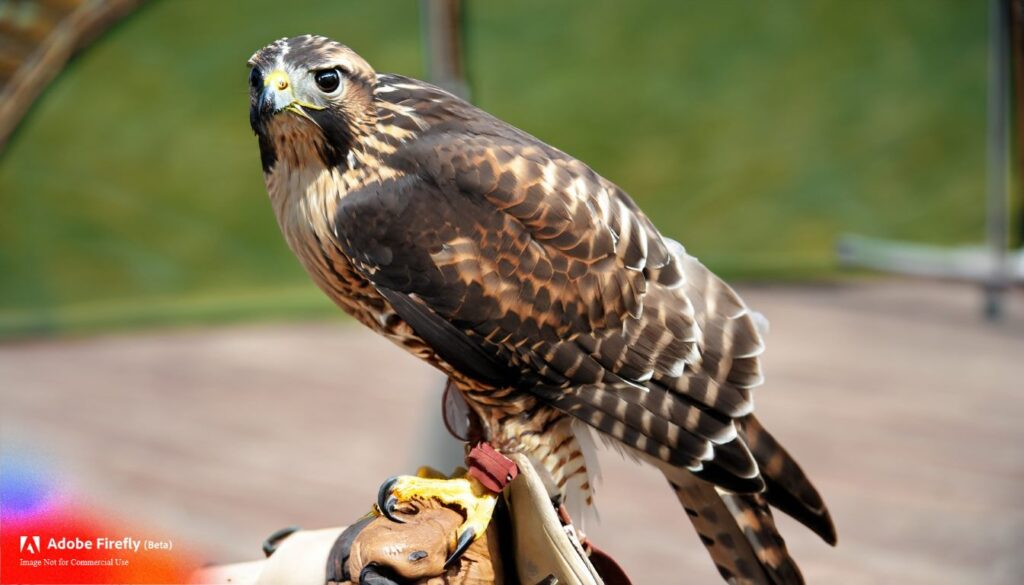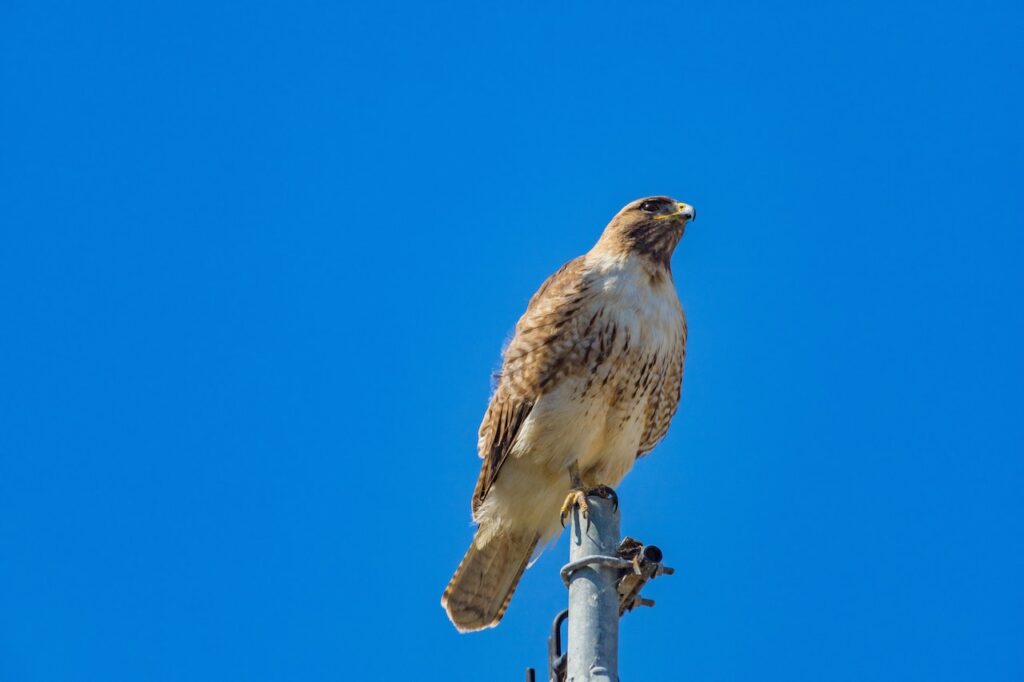
Can I Tame A Wild Hawk? Well, that’s a topic of curiosity and questions.
Having birds as pets is quite a long-followed pattern across the world. However, the idea of taming Wild Hawks brings out a lot of queries.
Join us as we guide you through the journey to transform Wild Hawks into companions. Since this delicate art demands both patience and understanding, it is not everyone’s cup of tea. This endeavour, in fact, also comes with its fair share of risks and legal considerations.
This article today will delve into the process of taming a Wild Hawk. From all those steps required to build trust with a wild hawk to the potential dangers posed by their powerful talons and beaks and the important legal landscape that surrounds this practice, we will cover it all.
So, if you’re captivated by the idea of taming a wild hawk, make sure you read the article till the end.
Can I Tame A Wild Hawk?
Taming a wild hawk is like making a new friend, but it’s not simple. This meticulous process demands time and expertise, along with consistent interaction for undisputed bonding.
Hawks are strong, with sharp claws and beaks, so there’s a risk of getting hurt. To form a connection with these wild birds, it is important to have a deep understanding of their behaviour and temperament.
Besides that, whether or not you can tame a wild Hawk depends upon the area you live in. From different legal aspects to local regulations, requiring a permit and more such aspects can add to the challenge.
Overall, while taming a Hawk is achievable, it is equally challenging and, in fact, not suitable/ possible for everyone.

Taming a Wild Hawk: Factors to Consider
If the idea of taming a Wild Hawk ever comes to your mind, here are some considerations you must know about:
- Time and Patience: Building trust, especially with Hawks, takes time, more than you may think. To make Hawks feel safe with you, spending consistent time together may help.
- Understanding Behavior: Hawks have sharp claws and beaks, so knowing how they act is important. To prevent any danger, it is important to learn their body language.
- Potential Risks: Hawks are powerful birds, and their talons and beaks can cause injuries. Taking precautions reduces the risk of accidents during the taming process.
- Legal Regulations: Laws about taming wild birds vary from place to place. Some regions require special permits to tame and keep wild hawks. Whereas many areas don’t allow taming wild birds at all, in fact, doing so can end up in legal trouble.
- Safety Measures: Wearing protective gear, like gloves, helps prevent injuries. Creating a safe environment that can reduce risks for both you and Hawk is important.
- Expert Guidance: Getting advice from experienced professionals ensures a safer and more successful taming process. Since Hawks are wild birds, the best practice to build a bond with them is by learning from experts.
- Ethical Considerations: Taming a wild hawk can affect its natural behavior and habitat. Learning that their place in the ecosystem is more important than in any domestic space is crucial.
- Long-Term Commitment: Taming a wild hawk means committing to its care for its entire life. Considering the responsibilities involved in long-term hawk companionship is crucial.
- Health and Nutrition: Providing proper food and care maintains the hawk’s health. Therefore, it is important to understand their dietary needs during the taming process.
- Trust Building: Slowly introducing yourself to the hawk helps them feel comfortable. Gradual trust-building increases the chances of a successful bond.
What are the “Possible” Risks and Laws Involved in Petting a Hawk?

Source : pexels.com
While Taming a Hawk can be fascinating for many, it carries potential risks and lawful challenges. For instance:
List of Possible Risks:
- Hawks have sharp talons and beaks that can cause injuries if not handled carefully.
- A Hawk might show aggression during taming, leading to unexpected actions.
- The process of taming a Hawk can be stressful for the bird and may impact its behaviour and health.
- There’s a slight risk of disease transmission (Zoonotic Diseases) from hawks to humans if proper hygiene isn’t maintained.
- There is a high chance the hawk might escape. Especially if not properly secured, this could invite a risk.
List of Laws Involved:
- Wildlife Protection Laws: Capturing and taming wild birds, including hawks, may be regulated to protect the species and their habitats.
- Permits: Many places require special permits to keep and tame wild birds. Keeping Hawk without a permit or violating any related regulation can result in legal consequences.
- Protected Species: Some hawk species are protected due to their rarity or threatened status, making taming without proper permits illegal.
How can one obtain the permits to tame Hawks and other wild birds?
Obtaining the necessary permits to tame hawks and other wild birds isn’t a very straightforward process. And even if it is, obtaining success isn’t necessary for all.
The process involves a few key steps, including:
- Research local regulations and specific laws governing the taming and keeping of wild birds in your region. Every region (State/ Country/ Territory) may have different laws/requirements, so check accordingly.
- It is best to reach out to your local wildlife or environmental authorities for information on permits to tame a hawk. They can also guide you through the application process in your locality.
- Fill out the required permit application accurately and thoroughly. If you have prior experience with birds of prey, it may help you during the application. Also, do mention your intentions for taming Hawks.
- To obtain the necessary permit, you will need to provide supporting documents, including your qualifications, experience, and details. Your financial background and the enclosure where you plan to house the hawk are also necessary.
- Some authorities might require you to demonstrate your knowledge and capability to care for and tame a hawk in the form of an interview or a practical test.
- Be ready for application fees associated with obtaining the permit, a hefty amount sometimes.
- After submitting your application, be patient since the approval may take time.
- Once your permit is granted, make sure to follow any conditions or guidelines set by the authorities. The authorities may visit you to check housing, care, and regular check-ins.
Please Note: The process of application can vary depending on your location and the specific species of hawk you intend to tame.
Legality of Taming Hawks in Different Parts of the World
The legality of taming hawks varies from place to place due to differing wildlife regulations. Here are a few examples of regions where taming (might) is allowed under specific conditions:
- United States: Taming hawks and other birds of prey might be possible only with proper permits and adherence to federal and state regulations. For activities involving birds of prey, U.S. Fish and Wildlife Service issues permits.
- United Kingdom: Taming hawks is regulated under the Wildlife and Countryside Act 1981 in the UK. Under specific licenses and conditions, practicing Falconry is important.
- United Arab Emirates: Falconry is deeply rooted in Emirati culture, and the UAE permits falconry under regulations to protect both the birds and their habitats. A similar is applicable to Qatar as well.
- Australia: Only allowed in some states under certain licenses. However, remember that laws can vary significantly between regions.
- Canada: Permitted under provincial regulations, with the specifics varying from one province to another.
It’s important to note that even in places where taming hawks is allowed, it typically requires proper permits, training, and adherence to specific conditions.
Wrapping up…
Overall, taming wild hawks is a complex and intricate task. Such practices require a deep understanding of Hawks, potential risks, legal requirements, and ethical concerns. One has to navigate through multiple layers of factors to achieve a successful outcome.
While places like the U.S., UK, UAE, and Qatar permit it, obtaining permits and prioritizing safety is important worldwide.

Hi, There and Welcome to BirdsNews.com, is here to help you learn and care about pet birds. and this blog is a journal of everything I’ve learned.
